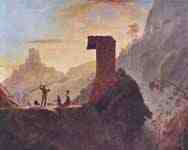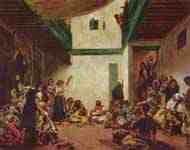Art Museum, Worcester (Massachusetts)

Portrait of Mrs. E. Freake and her daughter, American painter of 1674

Portrait of William Carpenter, Ralph Earl

The Pouting (Te Faaturuma ), Paul Gauguin

Mary Magdalen in Penitence, El Greco

Visit to the library, Pietro Longhi

St. Mary's Chapel at Subiaco, Samuel Finley Breeze Morse

Jewish wedding (after Delacroix), Pierre-Auguste Renoir

Arrangement in Black and Brown: The Fur Jacket, James Abbott McNeill Whistler
----
Fine Art Prints | Greeting Cards | Phone Cases | Lifestyle | Face Masks | Men's , Women' Apparel | Home Decor | jigsaw puzzles | Notebooks | Tapestries | ...
----
The Worcester Art Museum, also known by its acronym WAM, houses over 35,000 works of art dating from antiquity to the present day, representing cultures from all over the world. The WAM opened in 1898 in Worcester, Massachusetts, and is the second largest art museum in New England.[2] The WAM also has a café, museum shop, library, and a year-round roster of classes for children and adults.
History
The Brooding Woman, Paul Gauguin, Worcester Art Museum. One of the four works stolen in 1972 but recovered soon after.[3]
In September 1896 Stephen Salisbury III and a group of his friends gathered together to created the Art Museum Corporation. Salisbury then gave a tract of land, on what was once the Salisbury farm (now fronting Salisbury Street in Worcester, Massachusetts), as well as $100,000 USD to build an art museum. The museum was designed by Stephen C. Earle, a Worcester architect, and formally opened in 1898.[4] The museum's collection at this point consisted largely of plaster casts of "antique and Renaissance" sculptures as well as a selection of 5,000 Japanese prints, drawings, and books, willed to the museum from John Chandler Bancroft, son of John Bancroft.[4]
In 1905, Stephen Salisbury died and left the "bulk" of his five million-dollar estate to the museum.[5]
The Worcester Art Museum continued to grow and slowly gathered a world-class art collection. The WAM became the first museum in the United States to purchase works by Claude Monet as well as Paul Gauguin. The museum was also the first institution to transport a medieval building, a chapter house, from Europe and install it in America.[6]
Hector Pioneer made in Worcester Art Museum by John A. Wilson (1923)
Between 1932 and 1939, the Worcester Art Museum joined a consortium of museums and institutions to sponsor expeditions to the archaeological sites where the city of Antioch once stood. This group of museums, including Princeton University, the musée du Louvre, the Baltimore Museum of Art, and Harvard University's affiliate Dumbarton Oaks, discovered hundreds of intricate floor mosaics. the Antioch mosaics as they are now known, were split up among the institutions The WAM received many mosaics including the Worcester Hunt, which now is installed in the Renaissance Court's floor.[7]
On May 17, 1972, The Art Museum suffered a major theft of artwork. Two men wearing masks entered the museum just before closing and shot a guard in the side.[8][9] The two men stole The Brooding Woman and Head of a Woman by Paul Gauguin, Mother and Child by Pablo Picasso, and St. Bartholomew by Rembrandt, a collection of works worth over one million dollars.[9] Four individuals were charged with the theft as well as the theft of seven artworks stolen from the Boyden Library at Deerfield Academy.[8]
Beginning in the 1990s, the WAM began renovating all of its galleries.[10] Beginning with the European galleries and then the Chinese Decorative Arts Gallery,[10] the museum then moved onto its Early American Galleries, and Art Since the Mid-20th Century Galleries.[11] The Art Since the Mid-20th Century galleries had been closed for about a decade before they were reopened as part of this program. The renovation of there two galleries cost 85,000 USD and included new flooring, lighting, wall refinishing, and some conservation work.[11]
Architecture
The Worcester Art Museum started as a small three-story building, designed by Stephen Earle and constructed by Messrs. Norcross Brothers, in 1898.[4] Very little of the exterior this original building can be viewed due to the multiple expansions the museum has undertaken.
In 1927, the Museum purchased a 12th-century French chapter house that was originally part of the Benedictine Priory of St. John at Le Bas-Nueil near Poitiers. Installed in 1932 and linked to the Museum in 1933 via the grand Renaissance Court, the chapter house was the first medieval building ever transported from Europe to America.[12] In 1933 alone, the Museum attracted 200,000 visitors.
Decorating the Renaissance Court floor is unequivocally one of Worcester's greatest ancient treasures – a group of Antioch mosaics dating from the first through the sixth century A.D. that was excavated at Antioch in Syria. The Worcester Art Museum supported the excavation between 1932 and 1939 in partnership with universities and other Museums.
The Museum building has expanded several times, in 1940, 1970 (Higgins Education Wing addition), and 1983 (Frances L. Hiatt Wing for special exhibitions; study and storage area for prints, drawings, and photographs; and an expanded conservation area). The Higgins Education Wing contains studios and classrooms, a professional printmaking studio, a computer studio, photography lab and an exhibition space for student works.
Worcester Art Museum is currently working with WHY Architects to create a new ramp at the Salisbury Street entrance to the museum.[13]
Collection
Sarah Wentworth Apthorp Morton, Gilbert Stuart, Worcester Art Museum
Monhegan Island, George Wesley Bellows, Worcester Art Museum
In addition to the Roman mosaic-laden Renaissance court and French chapter house, strengths of the permanent collection include collections of European and North American painting, prints, photographs, and drawings; Asian art; Greek and Roman sculpture and mosaics; and Contemporary art.
European paintings include some fine Flemish Renaissance paintings, an El Greco, a Rembrandt, and a room of Impressionist and 20th-century works by the likes of Monet, Matisse, Renoir, Gauguin, and Kandinsky. The American painting collection includes works by Thomas Cole, Winslow Homer, John Singer Sargent, William Morris Hunt, Elizabeth Goodridge, among others. In the 20th-century gallery, the Museum displays works by Franz Kline, Jackson Pollock, and Joan Mitchell. Notable works include:
El Greco, The Repentant Magdalene, about 1577
Claude Monet, Water Lilies, 1908 and Waterloo Bridge, 1903
Rembrandt Harmenszoon van Rijn, St. Bartholomew
Paul Gauguin, The Brooding Woman, 1891
Edward Hicks, The Peaceable Kingdom, about 1833
Vincent van Gogh, Portrait of a Man in a Top Hat, 1882
Pierre-Auguste Renoir, Coco Eating His Soup, 1905
Paul Cézanne, Study for The Cardplayers, 1890–1892
Pablo Picasso, Portrait of Fernande Olivier, 1906
Piero di Cosimo, Discovery of Honey, 1505–1510
Taddeo di Bartolo, Christ Meeting Mother on Way to Calvary
Paolo Veneziano, Altarpiece With Saints
Pieter Jansz. Saenredam, Church Interior
Master of the Northbrook Madonna, The Virgin and Child (The Northbrook Madonna)
Nam June Paik, Robert Goddard
Gonçal Peris Sarrià, Saint Bartholomew
John Singleton Copley, Lucretia Chandler
Winthrop Chandler, Homestead of Thomas Ruggles
In 1901, John Chandler Bancroft, a wealthy Bostonian, bequeathed more than 3,000 Japanese prints. The Bancroft collection spans the history of woodcut printmaking in Japan, with particular strength in rare, early images from the late 17th and 18th centuries. Salisbury's estate donation included many portraits commissioned by his family, as well as sculpture, furniture, and silver. These works, by artists such as Gilbert Stuart, Thomas Crawford, and Samuel F.B. Morse and the craftsmen Paul Revere, Edward Winslow, and Nathanial Hurd, constituted the nucleus of the American collections. Today, the museum’s $85 million endowment includes about $20 million reserved for acquisitions, providing about $1 million a year to spend.[14]
In 2013, it was announced that the museum would be absorbing the collection of the Higgins Armory in spring of 2014.[15]
Management
In the first part of the 20th century, as many as 200,000 people visited the Worcester Art Museum each year. These days, the museum runs a $1.5 million deficit on a $9 million budget. In 2012, its endowment was at $90 million.[16]
References
"New Director Announced". Worcesterart.org. 2014-02-13. Retrieved 2014-06-25.
"Traditional Fine Arts Organization WAM site". Tfaoi.org. Retrieved 2014-06-25.
Miner, Bradford. "40 years since heist at Worcester Art Museum". Telegram. Retrieved 25 July 2012.
New Art Museum. New York Times. July 6, 1902. Retrieved February 21, 2011
Salisbury's Bequests. November 21, 1905. Retrieved February 21, 2011
Massachusetts Museums Offer Art, Science. Daily Gazette. June 13, 2003. Retrieved February 24, 2011
Worcester Art Museum Restores Border Panels to Worcester Hunt, Largest Antioch Floor Mosaic in America. Worcester Art Museum. Retrieved January 26, 2011
Suspects in Art Theft Face Court on June 1. The Telegraph. May 23, 1972. Retrieved February 21, 2011.
Thieves Take Art Works. Victoria Advocate. May 18, 1972. Retrieved February 21, 2011
Worcester Art Museum unveils modern art exhibit. Boston Herald. February 19, 2011. Retrieved February 21, 2011.
Sheehan, Nancy. 20th century redux at Worcester Art Museum: ‘Art of our time’ back at WAM. Worcester Telegram and Gazette. February 17, 2011. Retrieved February 21, 2011.
"From the Director" accessed on 2008-12-13
"Worcester Art Museum - Bridge - wHY". Why-site.com. Retrieved 2014-06-25.
Judith H. Dobrzynski (March 14, 2012), How an Acquisition Fund Burnishes Reputations New York Times.
Duckett, Richard (8 March 2013). "Higgins Armory Museum to close after 82 years". Worcester Telegram and Gazette. Retrieved 8 March 2013.
Geoff Edgers (June 20, 2012), Worcester museum opens front door Boston Globe.
Artist
A - B - C - D - E - F - G - H - I - J - K - L - M -
N - O - P - Q - R - S - T - U - V - W - X - Y - Z
Retrieved from "http://en.wikipedia.org/"
All text is available under the terms of the GNU Free Documentation License


